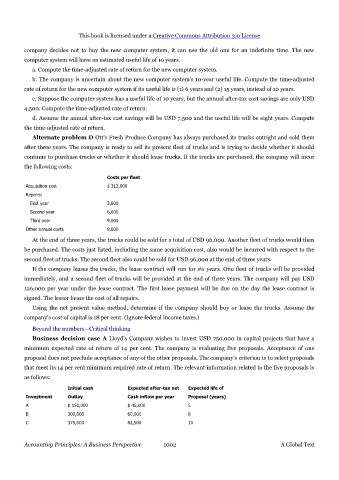Page 1001 - Accounting Principles (A Business Perspective)
P. 1001
This book is licensed under a Creative Commons Attribution 3.0 License
company decides not to buy the new computer system, it can use the old one for an indefinite time. The new
computer system will have an estimated useful life of 10 years.
a. Compute the time-adjusted rate of return for the new computer system.
b. The company is uncertain about the new computer system's 10-year useful life. Compute the time-adjusted
rate of return for the new computer system if its useful life is (1) 6 years and (2) 15 years, instead of 10 years.
c. Suppose the computer system has a useful life of 10 years, but the annual after-tax cost savings are only USD
4,500. Compute the time-adjusted rate of return.
d. Assume the annual after-tax cost savings will be USD 7,500 and the useful life will be eight years. Compute
the time-adjusted rate of return.
Alternate problem D Ott's Fresh Produce Company has always purchased its trucks outright and sold them
after three years. The company is ready to sell its present fleet of trucks and is trying to decide whether it should
continue to purchase trucks or whether it should lease trucks. If the trucks are purchased, the company will incur
the following costs:
Costs per fleet
Acquisition cost $ 312,000
Repairs:
First year 3,600
Second year 6,600
Third year 9,000
Other annual costs 9,600
At the end of three years, the trucks could be sold for a total of USD 96,000. Another fleet of trucks would then
be purchased. The costs just listed, including the same acquisition cost, also would be incurred with respect to the
second fleet of trucks. The second fleet also could be sold for USD 96,000 at the end of three years.
If the company leases the trucks, the lease contract will run for six years. One fleet of trucks will be provided
immediately, and a second fleet of trucks will be provided at the end of three years. The company will pay USD
126,000 per year under the lease contract. The first lease payment will be due on the day the lease contract is
signed. The lessor bears the cost of all repairs.
Using the net present value method, determine if the company should buy or lease the trucks. Assume the
company's cost of capital is 18 per cent. (Ignore federal income taxes.)
Beyond the numbers—Critical thinking
Business decision case A Lloyd's Company wishes to invest USD 750,000 in capital projects that have a
minimum expected rate of return of 14 per cent. The company is evaluating five proposals. Acceptance of one
proposal does not preclude acceptance of any of the other proposals. The company's criterion is to select proposals
that meet its 14 per cent minimum required rate of return. The relevant information related to the five proposals is
as follows:
Initial cash Expected after-tax net Expected life of
Investment Outlay Cash inflow per year Proposal (years)
A $ 150,000 $ 45,000 5
B 300,000 60,000 8
C 375,000 82,500 10
Accounting Principles: A Business Perspective 1002 A Global Text

